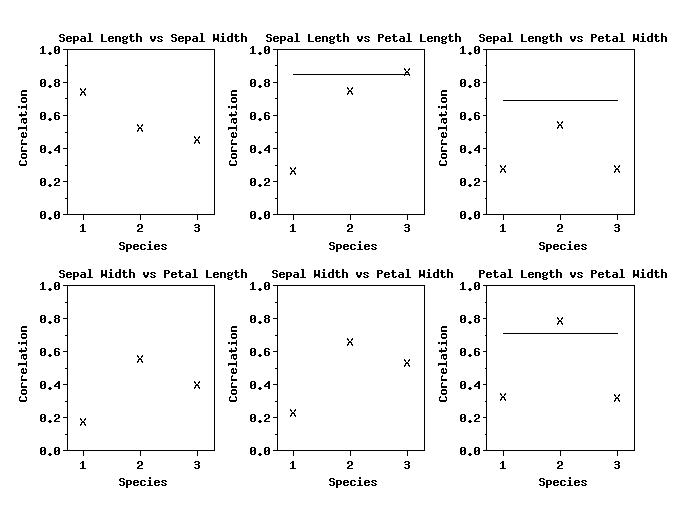

|
CORRELATIONName:
\( S_{yy} = \sum_{i=1}^{N}{(Y_{i}-\bar{Y})^2} \) \( S_{xy} = \sum_{i=1}^{N}{(X_{i}-\bar{X}) (Y_{i} - \bar{Y})} \) \( r = \frac{S_{xy}}{\sqrt{S_{xx}} \sqrt{S_{yy}}} \) A perfect linear relationship yields a correlation coefficient of +1 (or -1 for a negative relationship) and no linear relationship yields a correlation coefficient of 0. It may be of interest to determine if the correlation is significantly different than 0. The CDF value for this test is
where FCDF is the F cumulative distribution function with 1 and N - 2 degrees of freedom (N is the number of observations) and
with r denoting the computed correlation. The pvalue is 1 - CDF.
<SUBSET/EXCEPT/FOR qualification> where <y1> is the first response variable; <y2> is the second response variable; <par> is a parameter where the computed correlation is stored; and where the <SUBSET/EXCEPT/FOR qualification> is optional.
<SUBSET/EXCEPT/FOR qualification> where <y1> is the first response variable; <y2> is the second response variable; <par> is a parameter where the absolute value of the computed correlation is saved; and where the <SUBSET/EXCEPT/FOR qualification> is optional. This syntax computes the absolute value of the correlation coefficient. This is typically used in screening applications where there is an interest in identifying high magnitude correlations regardless of the direction of the correlation.
<SUBSET/EXCEPT/FOR qualification> where <y1> is the first response variable; <y2> is the second response variable; <par> is a parameter where the computed correlation pvalue is saved; and where the <SUBSET/EXCEPT/FOR qualification> is optional. This syntax computes the pvalue (described above) of the correlation.
<SUBSET/EXCEPT/FOR qualification> where <y1> is the first response variable; <y2> is the second response variable; <par> is a parameter where the computed correlation cdf is saved; and where the <SUBSET/EXCEPT/FOR qualification> is optional. This syntax computes the cdf (described above) of the correlation.
LET A = CORRELATION Y1 Y2 SUBSET TAG > 2
Peavy, Bremer, Varner, Hogben (1986), "OMNITAB 80: An Interpretive System for Statistical and Numerical Data Analysis," NBS Special Publication 701.
2011/08: CORRELATION ABSOLUTE VALUE added 2012/06: CORRELATION PVALUE and CORRELATION CDF added
SKIP 25
READ BERGER1.DAT Y X
LET CORR = CORRELATION Y X
LET PVAL = CORRELATION PVALUE Y X
LET CDF = CORRELATION CDF Y X
SET WRITE DECIMALS 3
The following output is generated.
PARAMETERS AND CONSTANTS--
CORR -- 0.946
PVAL -- 0.000
CDF -- 1.000
Program 2:
SKIP 25
READ IRIS.DAT Y1 Y2 Y3 Y4 TAG
.
TITLE CASE ASIS
TITLE OFFSET 2
LABEL CASE ASIS
TIC MARK OFFSET UNITS DATA
Y1LABEL |Correlation|
YLIMITS 0 1
MAJOR YTIC MARK NUMBER 6
MINOR YTIC MARK NUMBER 1
Y1TIC MARK LABEL DECIMAL 1
Y1LABEL DISPLACEMENT 20
X1LABEL Species
XLIMITS 1 3
MAJOR XTIC MARK NUMBER 3
MINOR XTIC MARK NUMBER 0
XTIC MARK OFFSET 0.3 0.3
X1LABEL DISPLACEMENT 14
CHARACTER X BLANK
LINES BLANK SOLID
.
MULTIPLOT CORNER COORDINATES 5 5 95 95
MULTIPLOT SCALE FACTOR 2
MULTIPLOT 2 3
.
TITLE Sepal Length vs Sepal Width
CORRELATION ABSOLUTE VALUE PLOT Y1 Y2 TAG
.
TITLE Sepal Length vs Petal Length
CORRELATION ABSOLUTE VALUE PLOT Y1 Y3 TAG
.
TITLE Sepal Length vs Petal Width
CORRELATION ABSOLUTE VALUE PLOT Y1 Y4 TAG
.
TITLE Sepal Width vs Petal Length
CORRELATION ABSOLUTE VALUE PLOT Y2 Y3 TAG
.
TITLE Sepal Width vs Petal Width
CORRELATION ABSOLUTE VALUE PLOT Y2 Y4 TAG
.
TITLE Petal Length vs Petal Width
CORRELATION ABSOLUTE VALUE PLOT Y3 Y4 TAG
.
END OF MULTIPLOT

|
Privacy
Policy/Security Notice
NIST is an agency of the U.S.
Commerce Department.
Date created: 01/23/2013 | ||||||||||||||||||||||||